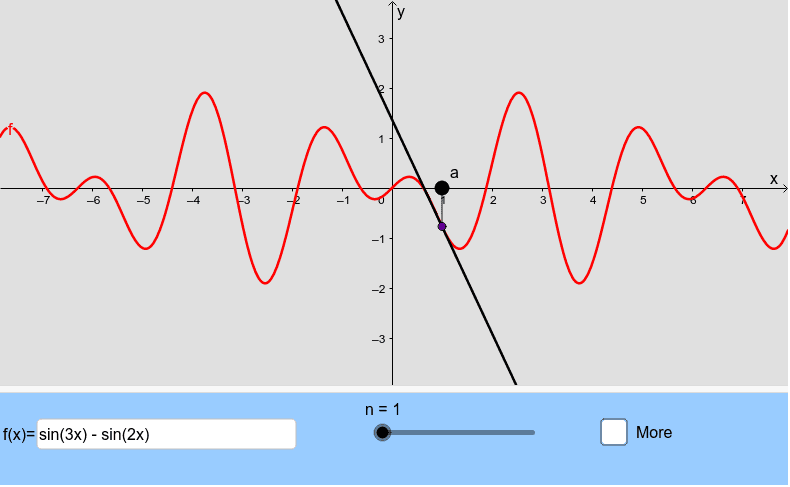5.2: Taylor Series
( \newcommand{\kernel}{\mathrm{null}\,}\)
For Real Functions
Let a∈R and f(x) be and infinitely differentiable function on an interval I containing a. Then the one-dimensional Taylor series of f around a is given by
f(x)=f(a)+f′(a)(x−a)+f″(a)2!(x−a)2+f(3)(a)3!(x−a)3+⋯
which can be written in the most compact form:
f(x)=∑∞n=0f(n)(a)n!(x−a)n.
Recall that, in real analysis, Taylor’s theorem gives an approximation of a k-times differentiable function around a given point by a k-th order Taylor polynomial.
For example, the best linear approximation for f(x) is
f(x)≈f(a)+f′(a)(x−a).
This linear approximation fits f(x) with a line through x=a that matches the slope of f at a.
For a better approximation we can add other terms in the expansion. For instance, the best quadratic approximation is
f(x)≈f(a)+f′(a)(x−a)+12f″(a)(x−a)2.
The following applet shows the partial sums of the Taylor series for a given function. Drag the slider to show more terms of the series. Drag the point a or change the function.

INTERACTIVE GRAPH
For Complex Functions
Suppose that a function f is analytic throughout a disk |z−z0|<R, centred at z0 and with radius R0. Then f(z) has the power series representation
f(z)=∞∑n=0an(z−z0)n,|z−z0|<R,
where
an=f(n)(z0)n!,n=0,1,2,…
That is, series (1) converges to f(z) when z lies in the stated open disk.
Every complex power series (1) has a radius of convergence. Analogous to the concept of an interval of convergence for real power series, a complex power series (1) has a circle of convergence, which is the circle centered at z0 of largest radius R>0 for which (1) converges at every point within the circle |z−z0|=R. A power series converges absolutely at all points z within its circle of convergence, that is, for all z satisfying |z−z0|<R, and diverges at all points z exterior to the circle, that is, for all z satisfying |z−z0|>R. The radius of convergence can be:
- R=0 (in which case (1) converges only at its center z=z0),
- R a finite positive number (in which case (1) converges at all interior points of the circle |z−z0|<R, or
- R=∞ (in which case (1) converges for all z).
The radius of convergence can be calculated using the ratio test of convergece. For example, if:
- limn→∞|an+1an|=L≠0, the radius of convergence is R=1L;
- limn→∞|an+1an|=0, the radius of convergence is R=∞;
- limn→∞|an+1an|=∞, the radius of convergence is R=0.
Dynamic Exploration
Use the following applet to explore Taylor series representations and its radius of convergence which depends on the value of z0.
On the left side of the applet below, a phase portrait of a complex function is displayed. On the right side, you can see the approximation of the function through it’s Taylor polynomials at the blue base point z0. The complex function, the base point z0, the order of the polynomial (vertical slider) and the zoom (horizontal slider) can be modified.
INTERACTIVE GRAPH
Maclaurin series
A Taylor series with centre z0=0
f(z)=∑∞n=0f(n)(0)n!zn
is referred to as Maclaurin series.
Some important Maclaurin series are:
11−z=∞∑n=0zn,|z|<1;ez=∞∑n=0znn!|z|<∞;sinz=∞∑n=0(−1)nz2n+1n!|z|<∞;cosz=∞∑n=0(−1)nz2nn!|z|<∞;sinhz=∞∑n=0z2n+1n!|z|<∞;coshz=∞∑n=0z2nn!|z|<∞;
Exercise 5.2.1
Exercise: Find the Maclaurin series expansion of the function
f(z)=zz4+9
and calculate the radius of convergence.
Note
The applet was originally written by Aaron Montag using CindyJS. The source can be found at GitHub.


